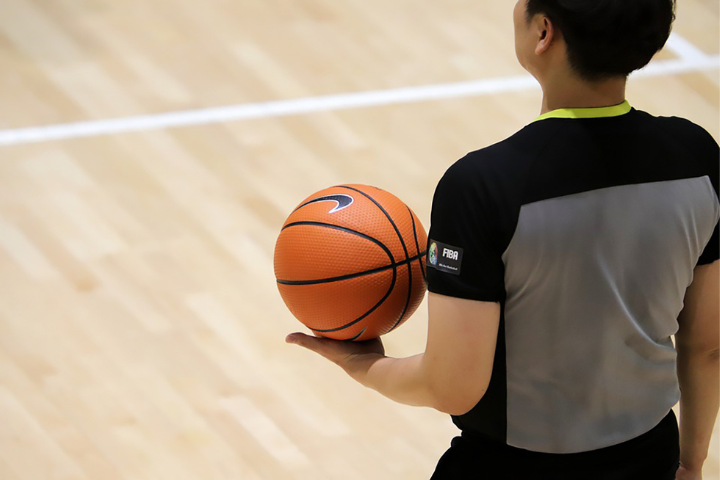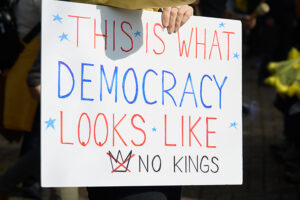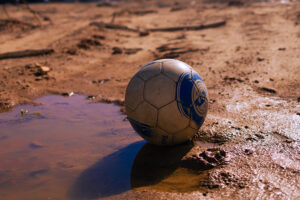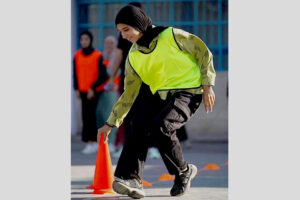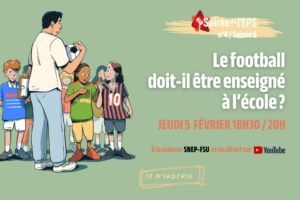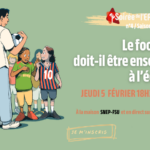Claire Pontais – PES and Society Center
In France, Physical and Sport Education (PSE) is a school subject for all pupils from nursery school to high school.
The school aims to give students a common culture. The “common base of knowledge, skills and culture” (2016) specifies that it “promotes the physical, cognitive and sensitive development of all students; that it allows to act, to conquer and to exercise progressively their freedom and their status as responsible citizens ».
Each school subject contribuate specifically to this global educational project, taking into account the needs of society and the evolution of social and cultural practices. Today, the teaching of the French language is based on literature, oral communicationand theater; the teaching of the arts is based on painting, sculpture, photography…; the teaching of technology on computer science, mechanics; musical education on choral singing; and PSE on the practice of sports and body arts (dances, circle arts).
This article analyzes the aims and challenges of PSE in schools in four parts. First : the analysis of social needs and inequalities in PSE education can help answer. Second : the missions and specific tools of the PSE to develop a physical culture. Thirdly : we will show that despite obstacles, PSE has the strengths to contribute to a more egalitarian and more emancipating school , and finally that thanks to school sport, it can create a link with physical practices beyond the school environment.
PSE and social needs
For a long time Physical Sport and Education (PSE) in France responded uniquely to military and/or hygienic concerns, without any reference to sport. Since the 1970s, physical, sporting and artistic practices are at the heart of PE teaching, while integrating changes in lifestyles (sedentary lifestyle, stress, etc.) and new needs (health, social cohesion, development of leisure activities, democratic life, etc.). These social practices are not imported as such into the school context but adapted to its objectives. In school, it is not just about « discovering activities », « learning a sport » or reaching your highest level in one sport ; nor simply to relax or move to fight against a sedentary lifestyle. The aim is to provide all students with critical access to a physical, sporting or artistic culture that can be a tool for learning about oneself, others and the world.
All students must be able to live experiences at school and acquire specific PSE skills: running, swimming, dancing, acting skillfully, playing together, mastering risk-taking, etc. The goal is to make the student able to go and practice activities outside of school, just as the teaching of the French language should encourage students towant to read or go to the library. As an adult, he will have to be able to make active leisure choices : practice regular physical activity adapted to his possibilities, be an actor in the associative world, be an informed and critical spectator, escape social or gender stereotypes, not suffer from the alienation caused by the merchantisation of sport or the “normalization” of their bodies (bodybuilding for boys or esthetics for girls…) and to become a parent who knows how to play with his children and make good educational choices for them.
This ambition requires having a living and open conception of the culture and knowledge to be transmitted, an emancipatory conception of citizenship (and not only obedience and respect for the rules, as is often the case) and a positive conception of health. Indeed, health is not only the maintenance of the « body machine » – even if it is of course necessary – it is also the capacity to act on its environment and to transform it. “There is a very strong link between health and creativity”, Yves Clot tells us, “health is an eminently cultural phenomenon (2009)1
Reduce inequalities in access to physical culture
There are glaring inequalities in access to physical culture. School, because it is the obligatory passage for all generations of children, has the mission of reducing these inequalities.
This is the ambition of all European countries.
- Social inequalities: while almost all children from advantaged backgrounds play one or more sports outside of school, those from disadvantaged backgrounds practice much less.
- Gender inequalities: girls practice less than boys and are confined to certain sports. Young girls from working-class backgrounds are thus struck by a « double penalty ». The vast majority of boys do not have access to artistic practices, many haverisk behaviors and / or have difficulty enteringthe school learning process.
- Territorial inequalities: between rural and urban areas, between rich towns and poor towns. Thus, for many children,school is the only occasion for cultural openness.
However, a child poorly physically educated has no real freedom because he remains a prisoner of his origins. A lot of girls don’t feel legitimate to practice in a club. Many women do not dare to play soccer, volleyball, table tennis in their leisure time, on the beach, at the campsite or in public parksfor their own pleasure. Theydo not dare to take their kids to the sea and let them play in the water. They are deprived of the formidable tool for development and emancipation that sports and artistic culture represent. Likewise, boys who do not dare to dance for fear of peer pressure, miss another experience of self awareness and enriched relationships with others.
The specific mission of the school: the study of physical, sporting and artistic practices
Like all school subjects, PES selects the knowledge, skills and methods that it requires students to study, so that they acquire constructed and reflected knowledge. In school, the pupil studies literary works, studies to solve scientific problems. Likewise, he actively studies sports and the arts which will enable him to acquire new “powers”:
- « Powers to act »: that is to say the ability to acquire techniques to access « extra-ordinary » motor skills (beyond ordinary motor skills). From an early age, children discover their bodies in unusual situations, learn to jump, to float, to control a ball, to dance, to play in a team…. They thus build aphysical knowledge of the world, acquire a body language which gives them power (ability) to communicate with others. This is the condition for each student to be able to make choices and to open up all possibilities for their whole adult life.
- « Thinking powers »to anylise the activity: that is to say, the ability to develope a methodfor « learning to train »: understanding the rules of the game, how to make them evolve, askingoneself questions in the face of failure, elaboratea learning project, make a tactical choice… It is also being able to make an objective judgment on one’s activity and those of others or a critical assesment of a sporting event.
- « Powers to learn together », by mixing and avoiding gender prejudices, doing common projects, acting with or against others within an ethical framework, practicing solidarity (team work) in action. By assuming different roles in order to progress in the specific activity (actor, spectator, judge, referee, observer, etc.), the student gains in autonomy and in the capacity to assume responsibility, qualities which are often reserved for children from more privileged backgrounds.
These three « powers » are intertwined. The « powers to act » make up the heart of the subject. They are a vital part of the teacher’s pedagogy. It is through this concrete learning that the major health and citizen (civic) education goals traditionally attributed to PES can be achieved. Without these real powers, these great purposes remain idle talk or an exercise in morality “spin”.
The “obligation to learn”
School is a specific environment. Students do not have a choice of class group, activity, study objects, or teacher. They are, moreover, in the « obligation to learn », with all that that means in terms of effort and uncertainties but also – and fortunately – of satisfactions and joys when one succeeds.
For teachers, this means “considering that each child is capable of learning and progressing” (Law for the Refoundation of the school of the Republic, 2013) : girls as well as boys, women and men ; those who initially “don’t like it” or feel too weak, too small or too over-weight … To allow the progression and success of all students, high-level professional training is necessary ; it must integrate psychology, sociology, learning theories, in-depth knowledge of Physical, Sporting and Artistic Practices and the ability to analyze one’s own teaching technique.
An open conception of culture
Sport culture is not just limited to televised sports or the rules set for the Olympic Games or International competitions. Culture is what humans invented to surpass themselves, to procure emotions, to play, solve problems, confront themselves, with others and in different contexts. The result today is a phenomenal amount of sports, institutionalized or other, outdoor activities, traditional and children games, dance, circus arts, maintenance or relaxation activities that are practiced for multiple reasons (health, competition, meeting, spectacle…) and are constantly evolving.
Within the large choice of Physical, Sporting and Artistic Practices, some are more adapted to the school context and to certain age groups. School curricula determine the common school culture. Choosing which practices to study at the School gives rise to heated debates among professionals. For example: should we teach dance, a culture of the sensitive and the imaginary, to girls and boys together despite the difficulties that this can provoke? Knowing that the majority of girls practice team sports in a club, should their teaching be reduced in school or, on the contrary, often schedule them so that they have access to the pleasure of team play? How to choose between rugby, badminton or wrestling, which are classified in the same category of subjects? How can we make students aware of the issues of warming-up, long-term effort, and preservation of their body, when these are not concerns of their age group …etc.
These debates are important and necessary, so that teachers can develop their skills in the full knowledge of the facts.
Adapting Physical, Sporting and Artistic Practices to the school context
It is necessary to adapt the rules and modes of practice to the conditions of the school so that the pupils can play and learn. A historical and anthropological analysis of the Physical, Sporting and Artistic Practices makes it possible to identify the emotions it provides. The relationship to the environment and the space it solicits, the problems it poses to the participants, the evolution of the rules since it’s origins. This analysis is very important, at all levels and in particular in nursery and primary school. It allows one to focus on the essential rules (getting rid of everything that is unnecessary or unsuitable for very young students) to create games and learning situations where the goal of the game, the criteria for success, the efforts to be made to learn, the roles to be played are very explicit for the students and teachers. This analysis also makes it possible to maintain the cultural content of Physical, Sporting and Artistic Practices : risk taking / risk control in gymnastics, speed of movement / map reading and orienteering, etc.
Obstacles and problems
The teaching of PSE today is faced with many obstacles, linked to its lack of recognition and lack of resources allocated by the national education system.
Despite an awareness of the need to play sports, and therefore of the role of PSE for health, well-being, citizenship, the system continues to prioritize school subjects and PSE is not a priority.
Likewise, the decline in public spending is having an impact on the creation of teaching posts and the various governments regularly attempt to have PSEsupervised by untrained staff and no longer teachers.
PSE hours continue to insufficient, 3 hours per week in primary and junior school, and 2 hours in secondary school. Only the 6th class (first year of college) benefits from 4 hours. Many primary schools lack facilities close to the school. Teacher training, which has long been considered very good, is now deteriorating.
The advantages of Physical and Sport Education (PSE) in France
The teaching of PSE, thanks to the training of teachers, has actively participated in the didactic and pedagogical advances of the last fifty years. It reflects on the content that is taught, how to assess students (with the idea of academic performance, continuous assessment and rather that sanctions) and furthermore, gender diversity and equality between girls and boys.
Another peculiarity: for almost a century PSEhad a specific Union which has a strong following amongst the profession. The SNEP (National Trade Union of Physical Education) is mobilized to ensure good working conditions, to defend initial and continual training, always with the aim of ensuring the success of all students in access to sports, culture. and artistic subjects.
In primary school, the presence of local and regional PSECounselors and is another asset that should be strengthened.
School Sport, another very important asset
In France there is a « school sport » which, for the pupils, is a natural extension of the PSE. In junior and secondary school, PE teachers have a 3-hour « package » included in their timetable to carry out this mission. For primary school, this is voluntary. The Sports Union for Primary Education (USEP) for primary education and the National Union for School Sports (UNSS) for junior and secondary schools bring together nearly two millions students, of 40% are girls. The success of school sport is due to the fact that students meet their classmates and teachers. School sports associations are places of innovation where mixed practices are invented, forms of meeting that do not eliminate anyone, where everyone plays for a long time, where everyone can access an emancipatory performance. The training of young officials; referees, organizers, reporters, managers, etc., constitutes a concrete apprenticeship in citizenship and responsibility.
A « bridging card » (Carte Passerelle) makes it possible to make the link between school and club sports: any student who has a school sport license has the right to go and try out different sports for free in a club in order to choose the sport that he or she is interested outside the school.
This is how in France PSE and school sport contribute, in their own way, to the development of physical, sporting and artistic culture. It is an exciting challenge for PE teachers who have often fought throughout history to preserve their discipline, the organization of which has no equivalent abroad and for which any countries can envy us.
- Yves Clot, Santé, culture et développement, 2009 http://epsetsociete.fr/Sante-culture-et-developpement [↩]

